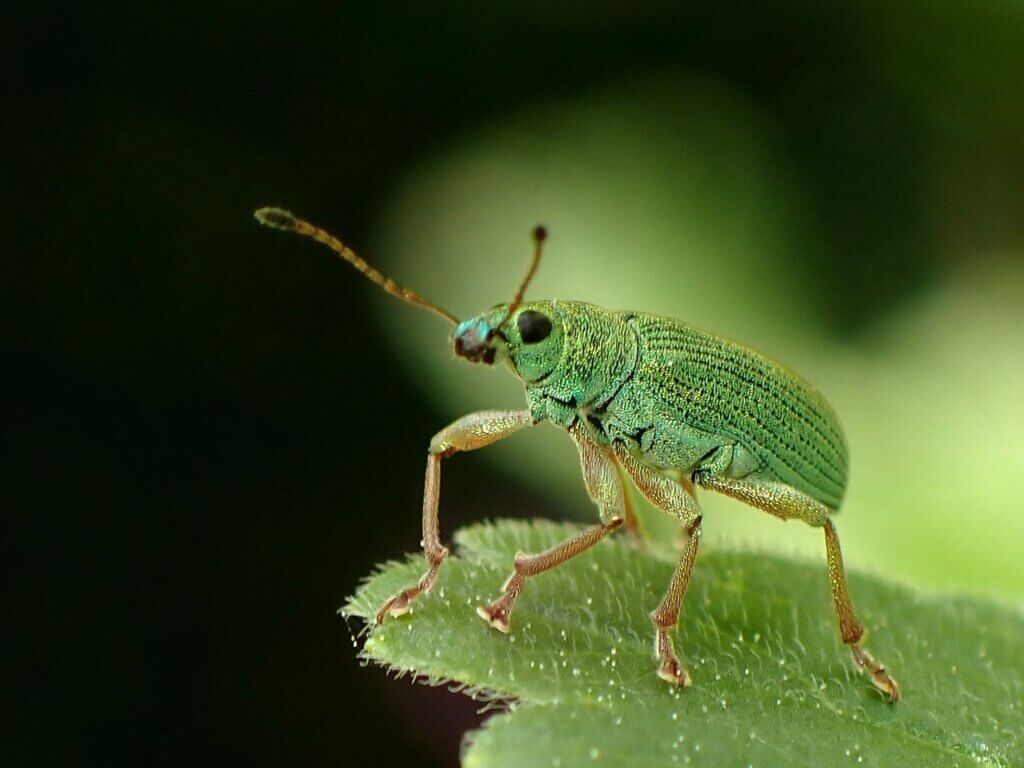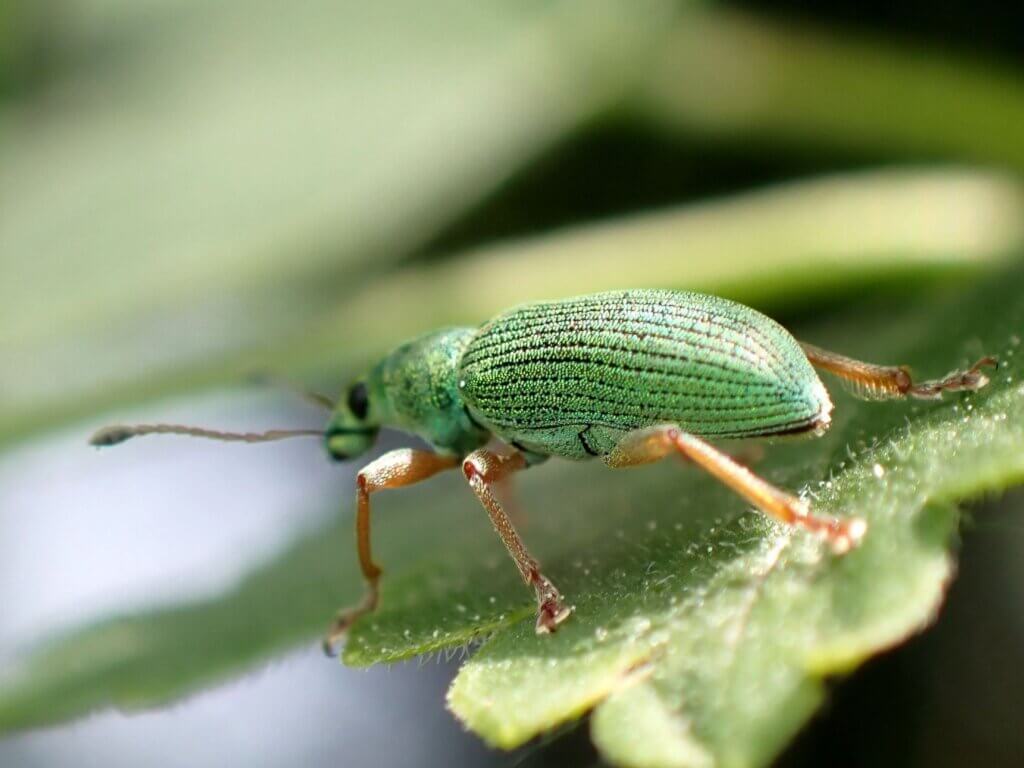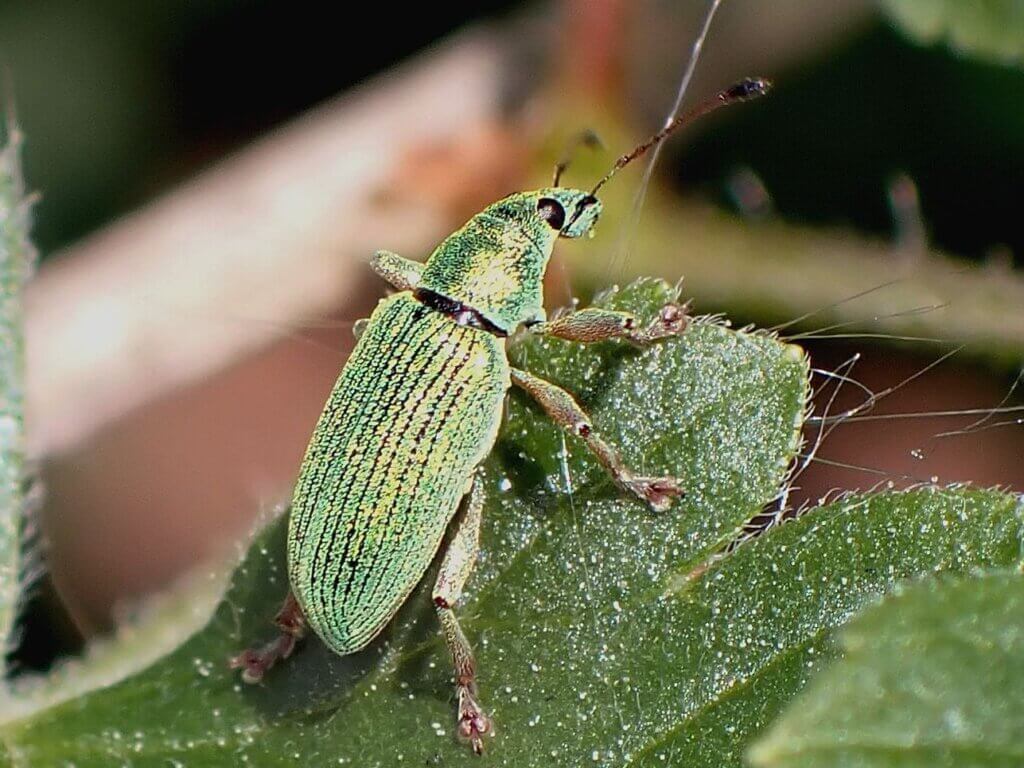
Jane is a naturalist, photographer and nature writer living in Dorset. Her work has appeared in books, anthologies and blogs for charities such as The Wildlife Trusts and the International Bee Research Association. When she’s not exploring Dorset’s lanes and countryside she can be found lying on her stomach watching insects in her garden. Jane’s entry for this blog’s Lockdown Nature-writing challenge was shortlisted and can be found by clicking here. www.janevadams.com and on Twitter @WildlifeStuff
A chance encounter with a weevil
Did you know that some female weevils can lay fertile eggs without needing a male? Or that when threatened some feign death by rolling onto their back? I certainly didn’t until a chance encounter sent me on a voyage of weevil discovery.

Polydrusus formosus doesn’t have a common name, but the Latin formosus means beautiful which seemed particularly apt when I spotted this tiny flightless beetle in my garden last week. If I’m honest I’ve never noticed weevils in the past but this one’s striking metallic colour, and similarity to a Clanger, soon had me reaching for my camera and looking for an identification on the internet.
Adults of this species are covered in round green scales when they first appear in April-May but these can easily rub off leaving them brown and under-dressed as they age. At 6mm long, and surprisingly speedy, one might catch your eye but you’ll be hard pressed to see much detail, it was only when I’d enlarged my photos that its true splendour revealed itself.

I’ve since read that there are over 60,000 species of weevil in the world, of which Polydrusus formosus is one of 480 in Britain. They’re obviously an adaptable little beetle as they range from Scandinavia, east to Siberia and throughout Europe and the UK, where the adults quietly nibble away on young leaves and blossom of some of our commonest trees and fruit bushes, such as oak, birch and gooseberry.
Females lay their eggs in soil so that the hatched larvae can feed on roots. By autumn they’re fully developed but stay underground until the following spring, which is when I spotted mine clambering over a gooseberry bush, and, in this weird no-mans-land of lockdown, embarked upon my weevil information quest.

Okay, yes, vine weevils might eat some of your pot plants, but I can’t wait to search for and record some of the other 479 species. Until I do I’m off to get my weevil-fix and watch an episode of The Clangers.
Footnote: Thanks to Max, Karen, Clive & Kevin at the Beetles of Britain & Ireland Facebook Group for their help during my weevil-quest.
Beetles of Britain & Ireland Facebook Group can be found at https://www.facebook.com/groups/889959111032221/
[registration_form]
Lovely blog. The most interesting thing I currently know about weevils (although as with all branches of natural history there’s an enormous amount I’ve still to learn) and which sprung to mind when I read this is that they were the dominant beetle group on St Helena, at least before the disruption caused when people settled it. This is the wonderful thing about these oceanic islands if an animal or plant manages to beat the odds and become established there they have an opportunity to diversify and create new species within a new developing ecosystem away from established mainland ones. It’s like being able to rerun evolution with a slightly different set of characters. So bloody tragic that these islands were incredibly fragile from a nature viewpoint and we’ve lost so very much e.g the Hawaiian mole duck only discovered via one piece of skull. This is another topic I don’t think gets the attention it deserves. https://www.nature.com/articles/017338a0
Thank you Les. Fascinating to hear about the weevils on St Helena, I didn’t know that. Thank you for the link, I’m looking forward to reading more about them.
Hi. Weevils are indeed, fabulous beetles. And as someone once might have said, “Fear no weevil”!
For those who are interested, the national recorder, Mark Gurney, has produced a series of fantastic pictorial guides available to download via this link
https://www.fscbiodiversity.uk/weevil-guides
Thank you for posting the link Richard. I came across Mark’s fantastic guides when I was trying to identify this weevil. Never let it be said that the internet isn’t useful!